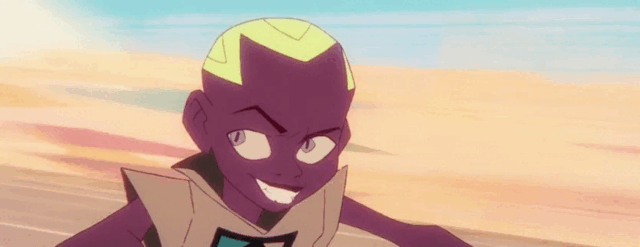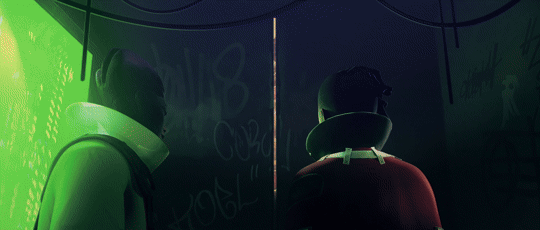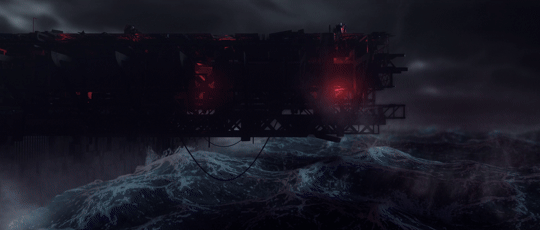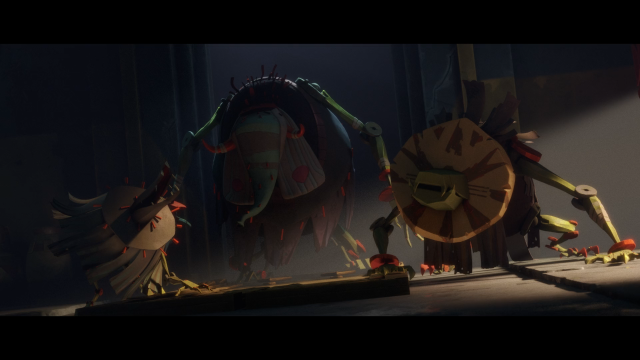originally posted at https://canmom.tumblr.com/post/734470...
Hey everyone. It’s Animation Night again. We aten'nt dead!!
Huge apologies to European viewers that I couldn’t stream this one earlier. Still, I’d like to get back into the swing of things, so we’re back. (Bros. We’re so back.)

So. tonight we’re gonna be checking out Kizazi Moto: Generation Fire. This is a collection of scifi films created by studios from five different countries across the length of Africa.
The impetus came from the South African studio Triggerfish - originally a stop motion studio, but they switched over to CG a few decades ago. We saw some of their work back on Animation Night 166 in Star Wars: Visions, which came close enough to the stop motion feel as to leave me in doubt. There’s no question they have a ton of talent.
Like Visions, this short film collection has the financial backing of the Mouse; it also has another American, Spiderverse director Peter Ramsey, serving as executive producer. But there’s no monolithic franchise involved this time - the individual directors and studios were given considerable creative freedom. Styles range from anime-esque to Hanna-barbera; stories span aliens in high speed races through near future dystopias to apocalyptic stories about gods.

The creators are a little hands off towards the term ‘afrofuturism’; in an interview with Skwigly magazine, producer Tendayi Nyeke asks us to interpret it just as scifi more broadly:
We don’t use the word Afro-futurist! Part of that is we are seeing science fiction, but through the context of Africa, and trying to demystify Afrofuturism. It’s not a genre for us. Because, you start to raise questions like can a French person do an afro futurist movie? And what does that even mean? So it’s an African filmmaker using science fiction as a medium to communicate. Science fiction allows them to imagine big futures. I love when a lot of Western science fiction is looking at a dystopian context, we’re looking at hope. It really comes from trauma in some ways, though we have a rich heritage prior to the trauma. And then we’re like, hey, technology is evolving. We’re evolving as human beings. If there was hope, what could that look like? Science fiction as a medium allows you to explore that just by its design.
Among the filmmakers, there is considerable ambition to change the general layout of the animation industry. Raymond Malinga, director of Herderboy, remarks:
But somehow, because of all these things like colonialism and everything, it’s almost like our creativity was stifled by that and we just keep on accepting the fact that we are supposed to tell mundane things, you know? Mundane. Normal. So with “Herderboy”, I just took one of the oldest professions of the whole continent. And I said if I can update that and Ugandans watch that, they can start saying, you know, if cattle herders can look cool, then what else can look cool?
It’s a cool interview, he’s very charmingly down to earth when he talks about how after working on the film for a year he has no idea what’s funny or not. Isn’t that a mood…
Of course, until fairly recently there were a lot more animated films about Africa, such as the French Kirikou series, than animated films created in Africa. Which is nuts when we’re talking about an entire continent, right? Thanks, “legacy of colonial extractivism”. But things are really moving now! African animation was the subject of Annecy 2021, and in the online version of the festival I got to see the impressively varied Mshini TV collection of the edgier end of the spectrum, which carried all sorts from Newgrounds-esque flashes to South Park-like comedy skits. And this year at Annecy 2023, I got to see the first feature-length animated film from Cameroon, The Sacred Cave. A bug is spreading!

With this field, Kizazi Moto stands out for its startlingly high level of technical polish. And of course, I just like scifi. From the Mouse’s perspective, they have their eye on the long game - trying to capture an 'emerging market’ and all that. But, I would far rather they spend their money this way than having animators add yet more weight to the sinking Star Wars boat, you know?
So let’s go take a look at what they’ve put together! In total, Kizazi Moto comprises 10 films, typically about 10 minutes long each. You can get summaries here or just watch along tonight, and I’ll be posting my thoughts on each one later~
And. For a dose of the heavy along with this fun stuff - the ongoing genocide has put Palestine and specifically the Gaza strip in the front of everyone’s minds. While there have been a few animated films touching on the occupation from the Israeli side, like Waltz With Bashir, a celebrated psychological drama in a realist style in which a former Israeli soldier reflects on whether he did a warcrimes, and Seder-Masochism, in which Nina Paley attempts to lay out a story about how the patriarchical Abrahamic religions suppressed an ancient matriarchal religion (she is a terf, how did you guess!), which includes the undeniably conceptually effective but highly equivocating This Land Is Mine segment… there is less available from the Palestinian side for the obvious and sad economic reasons.
But, a couple of weeks ago, Animation Obsessive wrote an article to celebrate Fatenah (2009), a short film animated in the West Bank about a woman in Gaza struggling to get breast cancer treatment. It’s available free on Vimeo:
It’s directed by Ahmad Habash, a native of the West Bank who came to study animation here in the UK, and secured WHO funding after they saw his student film. But the film is not a one-note activist project, it’s a careful character study trying to give a convincing portrait of the different facets of its title character’s life. This film was completely new to me and I’m grateful to AniObsessive for highlighting some Palestinian art in my favourite medium. So I’d like to slot this into my little Twitch show as well!
I have a bunch of other short films I’m excited to show, between recent Gobelins works and another AniObsessive piece highlighting their favourite short films from the festival circuit which have become available online. But given the ludicrously late start, I don’t want to pack too much in to this one. We’ll save that for another week!
I know Animation Night has been very spotty recently. I’ve been going through it with the old brain a bit ('a bit’ she says). I’m trying to get things back on track with sleep and stuff, thank you for all the kind things people have said, and for bearing with me.
So! Let’s go! Animation Night 177 will be going live in just a moment in its usual home, https://twitch.tv/canmom!
post-animation night 177 comments
brief thoughts on kizazi moto (more substantial tomorrow perhaps): visually that was so lush. we’re really full post-Arcane/Spiderverse nonphotorealistic stylings here, with a powerful dash of Trigger/Flying Bark-esque Neo Kanada School as well. this was like a cross-section of the current big styles in animation and it kicked ass for that. I’m not entirely sure what the production pipeline looked like - the Irish film board was apparently involved somehow! and maybe some Irish studios so it wasn’t a purely African production - but it was an extremely impressive showing all round.
narratively, putting it right beside Fatenah kinda highlighted the places it wasn’t willing to go. though I had heard the directors had a lot of freedom, there were some very consistent themes running throughout the anthology - nearly every film involved parent-child relationships, many of them revolving around a kid hoping to prove themselves in the eyes of their society/ancestors. the uglier side of history is touched on lightly: one film shows us a flashy cyberpunk city from an alternate timeline where ‘Great Zimbabwe was never colonised’, complete with 'the most advanced justice system in the multiverse’ (a giant robot bird that chases our protagonists), but doesn’t expand on that as more than a colourful backdrop. the last film gets closest, presenting a mother-child pair of two gods who are wounded by extractivism and retreat from the world - I appreciated the understated bleak implication of its ending.
I think while the creators were probably not given too much overt creative restriction, they were surely aware this was to be broadcast in English on Disney’s streaming service, and tailored their stories accordingly. so you’d probably avoid “Disney is the face of American imperialism: the movie”. Disney money is a bit of a double-edged sword that way.
besides parent/child reconciliation, we had a lot of ancestors and more than a few gods. a few stories centred on coming of age rituals; other had a more or less central focus on social media fame and its corrupting effect. at times it verges into the preachy - characters who stand between two families, or between humans and aliens, and resolve to honour both sets of ancestors - but the presentation is more than engaging enough to make it a compelling watch, regardless.
there’s a lot of wonderful lighting, set design and architecture throughout. Mọrémì had a very cool desaturated style with toyetic, colourful 'soul-stealing giants’ that put me a little in mind of Absolver.

Stardust had a bit of a Star Wars feel, almost feeling like an extra Visions short, but the injection of Islamic architecture was very effective.
a certain Arcane/Riot influence is very overt in many of the films - not just in the widespread use of paint textures in the CG environments and the approach to light and colour, but also with plot elements like the neon-drenched surfer gang in Surf Sangoma (episode 4) - which was definitely a fantastic-looking episode with the wonderfully out-there premise of a world where you have a squid suck on your face to gain surf skills. (just say no to squids, kids! you don’t need 'em! rely on your magic ghost mum instead.) but I think this is something that’s true in the animation industry more generally of late - the last few years have really kicked the door open to 2D stylings in 3D (paint textures, reduced framerates etc.). no doubt having a Spiderverse director as exec producer played a role in that too!
all in all I really enjoyed this anthology, and I’m super excited to see what comes next from the studios involved.
Fatenah meanwhile was fantastic, and an absolute gut punch. the fact that the hospital seen in the film has been in the news for being emptied out at gunpoint in the last week gave it a special level of 'oof’. its style may seem disarmingly simple, but the puppet-like styling ends up bestowing a huge degree of weight to the characters. the scenes of the border checkpoint, the monotony of cages and guards, and the concrete environment resembling a Half Life 2 map, were very impactful. highly recommend taking 20 minutes to watch this film.
Comments